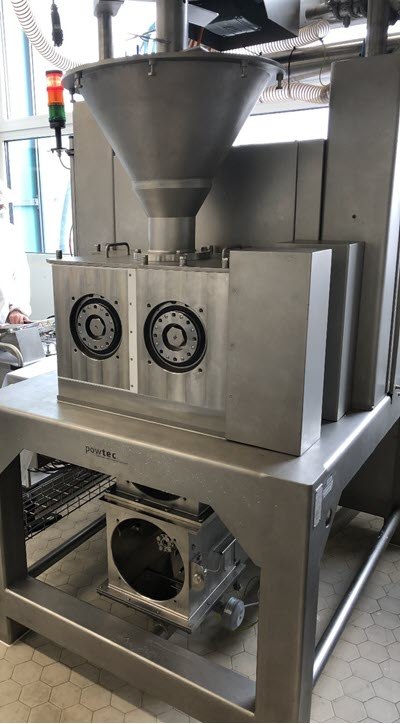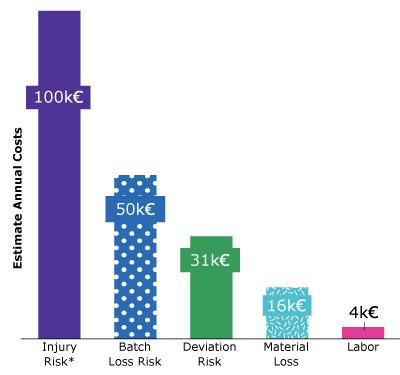Facilitate Handling of Bulk Powders with Dry Granulation

Roller compactor for dry granulation
Multi-ton quantities of bulk raw materials such as buffers, salts, and stabilizing chemicals are used throughout pharmaceutical and biopharmaceutical manufacturing workflows and typically prepared using a just-in-time approach to maximize efficiency. However, handling bulk powders at a large scale can be challenging for several reasons including:
- Some raw materials naturally tend to cake and can even completely solidify, which can lead to process delays and interruptions
- Weighing and dispensing steps of caked materials are time- and labor-intensive
- Dust formed during the handling process puts operators at risk
Handling caked raw material increases operational and safety risks as manual de-caking of solid blocks of bulk powders becomes necessary. This process not only delays project timelines, but it can also pose a risk of injury to the operator to break apart the solid mass manually. Caking, and especially severity of caking cannot be predicted, as it is caused and influenced by various parameters such as chemical characteristics, pressure, moisture, as well as transport and storage condition.
This process can also result in quality deviations, increase the risk of contamination, and escalate operational costs due to:
- Difficulty in sampling and weighing the caked materials resulting in batch-to-batch variations of the process or final product performance
- Negative impact on material processability, e g. prolonged dissolution time
- Additional effort to break apart solidified blocks affecting manufacturing timelines and needing additional resources and equipment, which also increases the risk for product contamination
- An inability to completely empty the primary packaging resulting in reduced material utilization
The mentioned difficulties and efforts that come along with caked raw materials also result in elevated costs. Figure 1 shows additional cost that can result from caking of bulk raw materials in an exemplary production setting.

Figure 1.Increased costs of manufacturing associated with the caking of raw materials in a typical production setting, resulting in estimated annual caking costs of ~200 k€**.
* Source: US Occupational Safety and Health Administration - www.osha.gov/safetypays/estimator
** Material and batch loss calculations highly depended on customer application and material
While minimizing material storage time and ordering smaller packaging sizes can help avoiding solidified material to a certain extent, it does not prevent it and also comes along with other difficulties, such as hampering just-in-time manufacturing processes.
Granulation Can Solve the Caking Problem
The underlying cause of raw material caking can be addressed by changing the physical form of the chemicals using granulation techniques. Compared to powders, granulated materials experience far less caking and as such, have better flowability and are easier to handle, even after long-term storage. Small clumps that may occasionally occur are typically easy to break, unlike the solidified blocks that can occur with powders. Granules thus offer better processability, accelerate manufacturing processes, and improve operator safety.
Granulation can be performed by two different main techniques: Dry granulation and wet granulation (Table 2). Dry granulation incorporates mechanical compression either by slugging or roller compaction while wet granulation typically uses a liquid and a binder to facilitate agglomeration of dry powder particles. Because dry granulation does not require a liquid/binder, it is preferred for compaction of chemical raw materials as their chemical composition is not altered.
With the slugging process, tableting machines or rotary presses form slugs which are then broken by a hammer mill to form granules. In roller compaction, the raw material is compressed into plates or sheets between two rotating rollers, which are then milled into granules. Compared to slugging, roller compaction is gentler, making it the preferred approach for heat- and moisture-sensitive raw materials. (1, 2, 3)
The Advantages of Dry Granulation by Roller Compaction
Figure 2 provides an overview of dry granulation using roller compaction. Bulk material is added to a funnel with a mixer and tamp auger that transports the material toward the rotating rollers. Hydraulic compression is then applied to form the plates. Because the high pressure can lead to an increase in temperature, the rollers are temperature-controlled to protect the raw material. The plates are pressed together and transported to the rotor sieve mill to produce the final granules at the desired size. Because fine particles that fall below the desired size can increase the probability of re-caking, they are recirculated to the funnel for a second round of granulation, thus minimizing product loss.

Figure 2.Principle of dry granulation by roller compaction. A typical roller compactor setup comprises (1) bulk material, (2) funnel with mixer and tamp auger, (3) hydraulic compression rolls (temperature controlled), (4) rotor sieve mill, (5) vibrating sieve, (6) final granules, (7) fine particles re-circulation.
Several process parameters must be considered to produce high-quality particles of a consistent size range using dry granulation and roller compaction.
- Pressure is a major determinant of the hardness and integrity of the granules. While there is an upper limit, higher pressures typically result in harder granules.
- Roller speed determines the retention time of the material under pressure. A faster speed results in higher throughput and the material is compressed for a shorter period. Rollers that rotate more slowly lead to a slower throughput and more highly condensed material.
- The pressure applied to the material is influenced by the space between the two rollers (the so-called interspace or gap). The smaller the interspace, the more the material is pressed together. This parameter is fixed during the process and must be aligned with the feeding speed; the interspace must be larger for more material to pass through the rollers.
- The size of the sieve mesh used during milling is the main parameter influencing particle size distribution.
- The chemical characteristics of the raw material including crystallinity, plasticity, and melting point help determine suitability for dry granulation by roller compaction. If the raw material is not suitable for roller compaction, there may be limited cohesion and no granules would be formed.
- Chemicals which have too little cohesion or are too sticky might not be suitable for granulation, so broad expertise is needed.
The Advantages of Granulated Raw Materials
Granulated raw materials produced using roller compaction have beneficial characteristics which translate into important advantages for drug manufacturing workflows. To systematically assess potential advantages of granulated materials, a case study was performed evaluating urea, glycine, and potassium chloride as model materials prone to caking in their granulated and bulk powder form.
Particle Size Distribution
Particle size of granules is always a distribution and is influenced by the mesh size of the milling sieve and the material itself. Figure 3 shows the distribution of urea particles following dry granulation with roller compaction using a milling sieve mesh size of 6 mm. The data confirm a very low portion of fine particles (< 1 mm) following an optimized process with recirculation of fines.

Figure 3.Urea particle size distribution following dry granulation using roller compaction.
Particle Appearance
Figure 4 shows the appearance of granulated urea (A) and potassium chloride (B) following a long-term stability study of 12 months at ambient conditions (25 °C / 60% relative humidity). The non-granulated bulk materials showed a high percentage of solidified blocks that were difficult to break apart (68% for urea and 42% for the potassium chloride). In contrast, the granulated urea and potassium chloride had significantly less caking (12% and 0% clumping, respectively) after 12 months in storage compared to the bulk material. The observed small clumps of granulated urea were easy to break apart in contrast to the hard clumps observed with the powder material.

Figure 4a.Appearance of granulated urea (A) and potassium chloride (B) following a 12-month stability study at ambient conditions (25 °C / 60% relative humidity).

Figure 4b.Appearance of granulated urea (A) and potassium chloride (B) following a 12-month stability study at ambient conditions (25 °C / 60% relative humidity).
Flowability
Granulated particles have increased flowability compared to bulk material as measured by a powder analyzer (Figure 5). In this study, material is placed on a rotating plate whose angle is then increased; the avalanche angle is that at which material starts to flow down the plate and ranges from non-satisfactory to excellent flowability. A lower avalanche angle indicates better flowability which translates to improved handling and processability.

Figure 5.Comparison of flowability of granulated and bulk raw materials. Flowability was determined based on the avalanche angle as measured using a powder analyzer: <45° excellent; 45–55° good; 55–62.5° average; >62.5° non-satisfactory.
Mechanical Stability
The mechanical stability of granulated particles can be evaluated under simulated stress conditions using a friability tester to determine the risk of crushing during transport, handling, and storage. In this study, granules were placed in an abrasion drum with heavy ceramic balls and the mass percentage of fine particles generated was determined. Abrasion of different granulated materials varied but was always less than 4%, indicating excellent integrity (Figure 6).

Figure 6.Abrasion of granulated materials under simulated mechanical stress conditions using a friability tester.
Dissolution Behavior
Focused beam reflectance measurement (FBRM) was used to determine dissolution kinetics for granulated and non-granulated material. In this method, a laser beam detects and counts particles within the solution. The dissolution behavior of granulated materials was comparable to the bulk material (Figure 7; Table 3), requiring only a slightly longer time which can be attributed to the lower surface area of the granulated material. Even with a slightly slower dissolution, the overall time savings as compared to caked bulk material is evident as manual de-caking, sampling, and weighing are not needed.

Figure 7.Dissolution kinetics of sodium chloride in granulated and bulk powder form as measured with focused beam reflectance measurement (FBRM).
Conclusion
Granulated chemical raw materials offer distinct advantages over raw materials in their non-granulated, powder bulk form. These materials:
- Outperform bulk material in terms of processability, performance, and ease of handling
- Demonstrate a strongly reduced tendency for caking
- Have improved flowability and similar dissolution behavior compared to bulk powders
- Maintain excellent integrity even under harsh mechanical stress
- Eliminate or significantly reduce the need for manual de-caking
Importantly, use of granulated materials offers important benefits to the pharmaceutical and biopharmaceutical manufacturing process. By significantly reducing the tendency of bulk materials to cake, flowability and processability are improved, enabling accelerated workflows, just-in-time production, and increased operator safety.
Related Products
References
To continue reading please sign in or create an account.
Don't Have An Account?